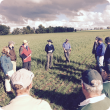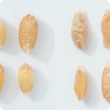Crops
The Department of Primary Industries and Regional Development continues to support the growth and international competitiveness of all crop industries in Western Australia.
With a 2400 kilometre span from its tropical north to its temperate south, WA supports a broad range of cropping industries from rain-fed winter cereals through to irrigated horticultural crops.
In the 2012/13 year the WA cropping industries exported a total of $3.9 billion which comprised: $3.1 billion of cereals, $859 million of pulses, pastures and oilseeds, $142 million of horticultural crops. The major contributors to these exports were wheat ($2.7 billion), canola ($756 million), barley ($377 million), lupins ($42 million), carrots at $48 million, oats ($12 million), and strawberries at $5.5 million.
Filter by search
Filter by topic
- (-) Remove Climate & weather filter Climate & weather
- Climate, land & water (53) Apply Climate, land & water filter
- Grains (38) Apply Grains filter
- Frost (20) Apply Frost filter
- Climate change (16) Apply Climate change filter
- Horticulture (10) Apply Horticulture filter
- Wheat (9) Apply Wheat filter
- Soils (9) Apply Soils filter
- Livestock & animals (8) Apply Livestock & animals filter
- Managing soils (6) Apply Managing soils filter
- Grains research & development (6) Apply Grains research & development filter
- Production & postharvest (5) Apply Production & postharvest filter
- Measuring and assessing soils (5) Apply Measuring and assessing soils filter
- Livestock management (5) Apply Livestock management filter
- Canola (5) Apply Canola filter
- Fire (5) Apply Fire filter
- Pastures (4) Apply Pastures filter
- Fruit (4) Apply Fruit filter
- Wine grapes (3) Apply Wine grapes filter
- Pulses (3) Apply Pulses filter
- Lupins (3) Apply Lupins filter
- Grains Research & Development (3) Apply Grains Research & Development filter
- Grapes & wine (3) Apply Grapes & wine filter
- Pests, weeds & diseases (2) Apply Pests, weeds & diseases filter
- Pasture management (2) Apply Pasture management filter
- Pome fruit (2) Apply Pome fruit filter
- Oats (2) Apply Oats filter
- Drought (2) Apply Drought filter
- Irrigated crops (2) Apply Irrigated crops filter
- Avocados (2) Apply Avocados filter
- Field peas (2) Apply Field peas filter
- Livestock species (1) Apply Livestock species filter
- Livestock research & development (1) Apply Livestock research & development filter
- Liming (1) Apply Liming filter
- Soil carbon (1) Apply Soil carbon filter
- Soil management (1) Apply Soil management filter
- Sowing (1) Apply Sowing filter
- Soil salinity (1) Apply Soil salinity filter
- Land use (1) Apply Land use filter
- Soil compaction (1) Apply Soil compaction filter
- Harvesting (1) Apply Harvesting filter
- Carbon farming (1) Apply Carbon farming filter
- Barley (1) Apply Barley filter
- Agribusiness Food & Trade (1) Apply Agribusiness Food & Trade filter
- Dry seasons and drought (1) Apply Dry seasons and drought filter
- Feeding & nutrition (1) Apply Feeding & nutrition filter
- Genetics & selection (1) Apply Genetics & selection filter
- Floods, storms and cyclones (1) Apply Floods, storms and cyclones filter
- Hay production (1) Apply Hay production filter










